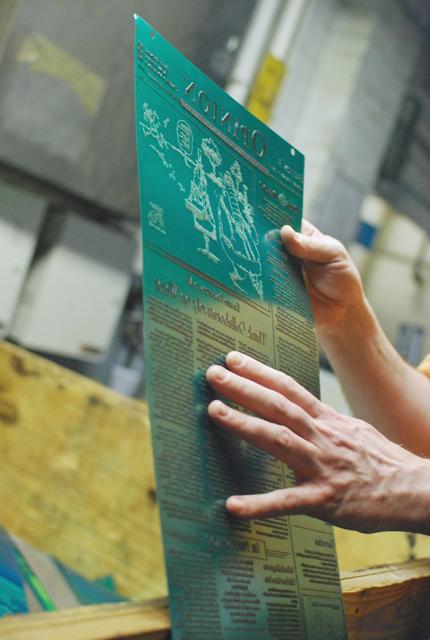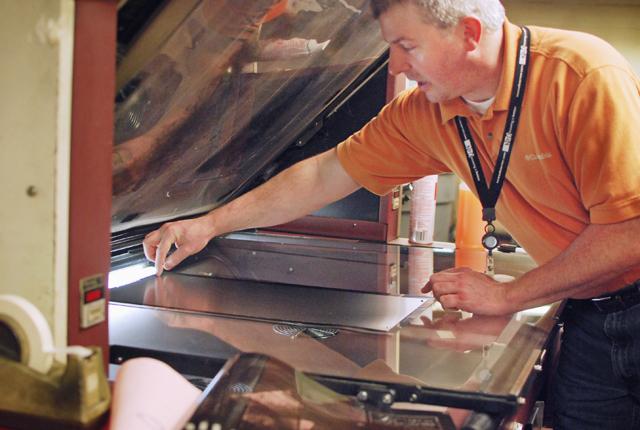Although the industry has experienced a steady decline for the past decade, newspaper companies are still cranking out daily publications. Celebration of technicians in the pressroom may be overshadowed by the work of writers and editors, but without these integral players, there would be no means to publish news.
The printing process has many complex components, but ultimately it all starts with paper. Newsprint is one of the most widely produced forms of paper. According to paper science professor Richard Phillips, the average newsprint mill can produce 1,000 tons of paper daily, comparable to eight million copies of the Technician.
Newsprint, unlike other forms of paper, uses a mixture of recycled fiber from old paper and new fiber derived from wood pulp, in a ratio of 70 to 30 percent.
“Recycled fibers require less energy to process,” Phillips said, “but it is more expensive per pound compared to buying soft wood. However, mills have to do more processing to the wood, which ultimately makes it more expensive.”
Wood chips go through a “digestion” process in which they are heated in water and macerated into a pulp, and this “virgin” fiber is introduced to recycled and cleaned newsprint fibers. There are over 10 million microscopic paper fibers in a single gram of pulp. This mash of fibers is mixed with water, in a ratio of 1 part fiber, 200 parts water. This mixture is then transferred onto a screen moving 120 miles per hour that removes water from the mash, and the paper fibers start to form a webbing, the basic premise of paper making.
Once this primitive form of paper is produced, it passes through a series of presses and drying rollers.
“After it leaves the moving screen, the paper is 20 percent solid,” Phillips said. “It will then go through this line of presses and rollers and it’s all about a quarter of a mile long.”
Since North Carolina does not have any newsprint mills, majority of the paper used for news come from mills in Georgia. Once rolls of paper arrive to newspaper companies, they are stored for printing.
The printing process has evolved since the first printing press into what is now used at the News & Observer local newspaper of Raleigh: a technique called “flexography,” in which the steel plates on print rollers come in direct contact with paper, acting like a large rubber stamp.
The printing process first starts with a photo negative of the images to be printed. This negative is used as a template to duplicate onto rubber-stamp-like steel plates.
According to Bruce Toy, pressroom manager of the News & Observer, the steel plates are lined with a photo-polymer that reacts with ultraviolet light. Once this polymer is exposed to the negative, it forms the “bump” on the plate, to act as a stamp.
“We then magnetically fasten these plates onto the rollers,” Toy said. “This comes not only in contact with the inking roller, but also directly in contact with the paper.”
The News & Observer, which also prints the Technician, has a margin of printing error of 2 percent, which is better than the industrial standard of 6 to 7 percent.
“There have been many times that the papers were dated wrong because they were sent incorrectly,” Toy said. “We’ve had papers that were webbed and cut wrong. Many times we’ve had to go straight back to the beginning and fix the negative.”
Toy said that these wasted papers go into the recycling steam of the pressroom and can be reprinted. However, Toy commented that this does not reflect well on the pressroom, which uses many of the company’s waning resources.
“The cost of printing is quite substantial,” Toy said. “With all the materials, people and resources, it’s not something we discuss lightly.”
Nevertheless, the News & Observer has seen a slight increase in productivity and revenue, according to Toy. Additionally, the paper industry had very successful years in 2009 and 2010. Although much of the news consumed in the U.S. is on T.V. or the internet, the forecast does not suggest that newsprint will completely disappear.
ALT Text Facts:
Attribute to Richard Phillips
Although recycled fiber for newspapers is a great way to be more environmentally conscious, it is important that “virgin pulp” from wood is used for the production of paper, not just from a structural integrity perspective, but from an environmental one too. With a steady demand for wood, private landowners will continue to invest in the production of their forests. Without demand, however, the land will lose value, and more likely than not is developed.
The fibers derived from newspapers can be recycled up to 6 times.
Bruce Toy, Pressroom Manager for the News & Observer, scans a negative section into a machine.









